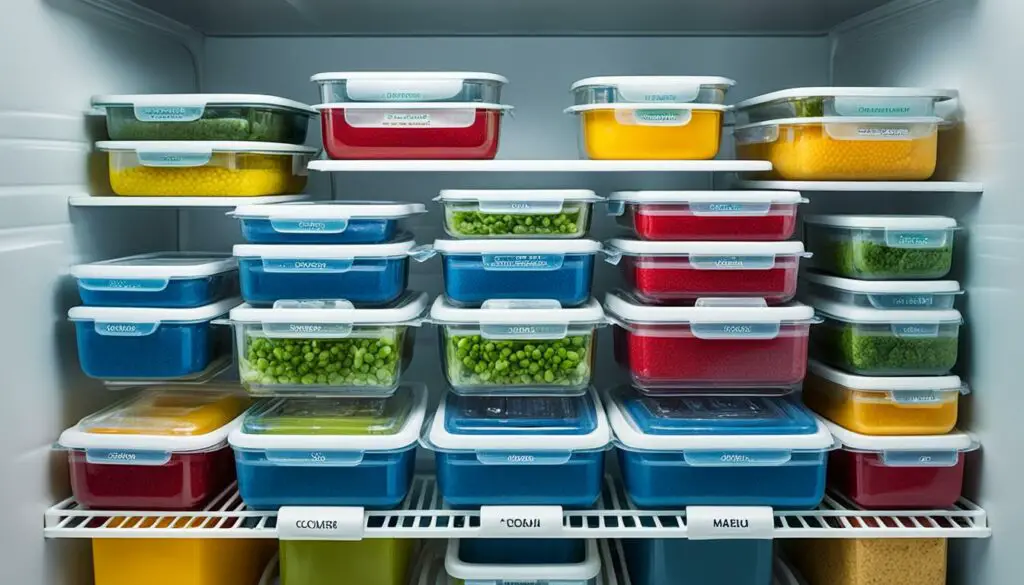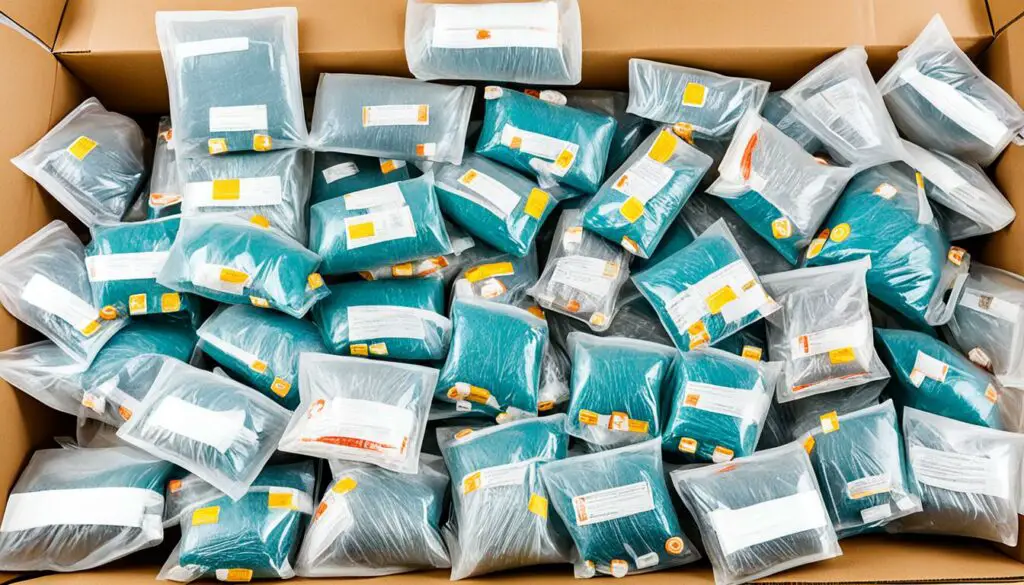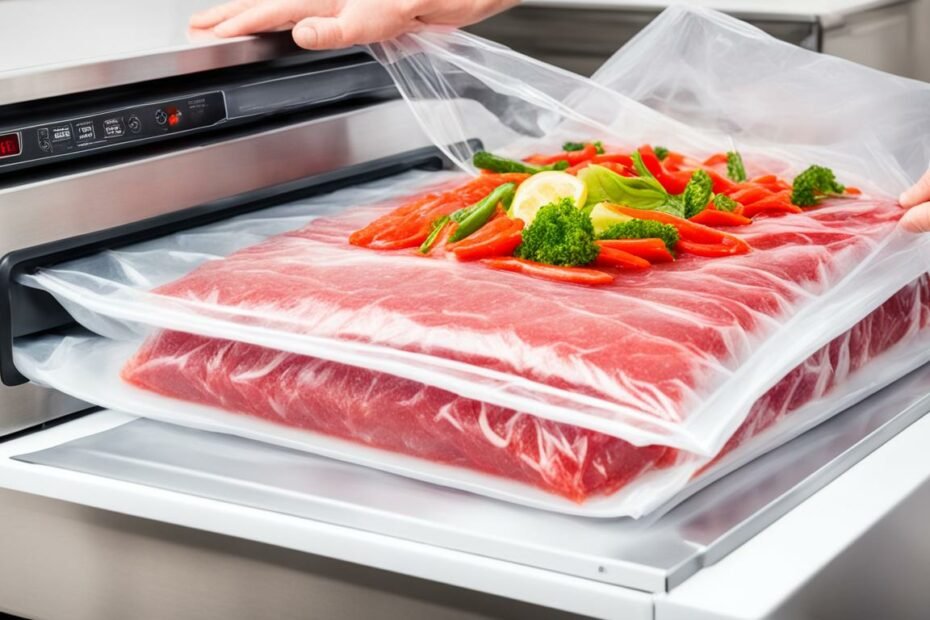Did you know that vacuum sealing cooked foods can help keep them fresh for up to 5 times longer? It truly does! This process gets rid of the air in the packaging. This tight seal then keeps the food’s taste and freshness.
Yet, not every cooked dish should be vacuum sealed. We’ll tell you all about the benefits and the risks of vacuum sealing cooked foods. Plus, you’ll learn when it’s not a good idea to use this method. If you’re curious about saving your leftovers this way, or if some foods shouldn’t be sealed at all, keep reading!
Understanding Vacuum Sealing and Its Effects on Food Texture
We’re going to look at how vacuum sealing changes the texture of cooked foods. This process shows how preserving food affects its feel and taste.
The Science Behind Vacuum Sealed Cooked Meats
Sealing cooked meats in a vacuum changes how they feel. No oxygen means proteins break down. This makes meats tender and juicy. It’s perfect for dishes like slow-cooked meals and sous vide cooking.
How Vacuum Packing Impacts Cooked Fish and Poultry
Vacuum sealing also helps fish and poultry. Removing the air keeps them moist. It holds the meats’ quality and flavor. So, your meals taste as good as they did when first cooked.
Textural Differences: Sous Vide Vacuum Percentages Explored
With sous vide, how much air you take out changes the food’s texture. More air out means firmer food. Less air gives you softer, juicier dishes. Chefs can pick the feel they want for dishes this way.
What Not to Vacuum Seal: Foods To Avoid
Some foods should not be vacuum sealed for safety reasons. It’s important to know which ones. This way, you can keep your food safe by avoiding certain items.
Anaerobic Bacteria and Food Safety
Keep in mind, some foods have anaerobic bacteria in them. These bacteria love places with less oxygen. When you vacuum seal food, you take out the oxygen. This can make the perfect condition for these bacteria to grow and make toxins.
These toxins are not safe for people to eat. So, it’s best to prevent sealing foods that might grow these dangerous bacteria. This helps keep the food you seal safe to eat.
The Risks of Sealing Certain Raw Foods
Raw foods also bring risks when vacuum sealed. The characteristics of some raw foods may make them spoil faster. For example, avoid sealing:
- Fresh mushrooms, because they can get damp and start growing bacteria.
- Garlic and onions, as their oils might go bad, changing their taste.
- Soft cheeses, such as Brie and Camembert, since they are moist and can spoil easily.
- Crunchy vegetables like cucumbers, lettuce, and celery. They won’t stay crisp when sealed and can change in taste.
Not sealing these raw foods can help keep your vacuum sealed stuff fresh. This way, you won’t risk spoilage and can enjoy better quality foods.
Using a vacuum sealer is great for storing food. But understanding what not to seal is key. Knowing about anaerobic bacteria and risky raw foods is crucial. It keeps your sealed meals both tasty and safe.
The Benefits of Vacuum Sealing Cooked Foods
Vacuum sealing can change the game for keeping cooked food fresh. It takes the air out of the package, so food doesn’t spoil as fast. This method keeps dishes tasting good longer. Let’s explore why vacuum packing your meals is a good idea.
Prolongs Shelf Life: Vacuum sealing makes food last longer. Without oxygen, bacteria have a hard time growing, so your food stays safe to eat. This means you can keep your meals longer without them going bad.
Preserves Flavor and Freshness: Food sealed with a vacuum stays fresher. It stops air and moisture from messing with your food’s taste. So, your meals will still be tasty and nutritious when you decide to enjoy them.
Reduces Food Waste: Vacuum sealing helps cut down on throwing food away. You can keep leftovers and meals longer, instead of tossing them. This saving not only helps your wallet, but it’s also better for the planet.
Enhances Meal Prep Efficiency: It makes getting meals ready much easier. With pre-cooked meals ready to heat, your time in the kitchen shrinks. Your food will be like it was just cooked, keeping everything fresh and easy.
Vacuum sealing cooked food has many upsides. It makes meals last longer, saves their flavor, and fights food waste. Plus, it makes your kitchen life simpler. For anyone who loves fresh, ready meals, using a vacuum sealer is a smart move.
Can I Vacuum Seal Cooked Foods? The Best Practices
Understanding the Ideal Conditions for Vacuum Sealing
To get the best out of vacuum sealing cooked foods, you need to use the right methods. Knowing how to vacuum seal properly can keep your food fresh and flavorful for a long time.
Start by making sure the food and vacuum sealer are clean and dry. This step is crucial because any dirt or wetness might stop a good seal. It could also make bacteria grow.
Choose good quality vacuum bags or rolls made for food storage. Pick ones that don’t have BPA and can handle the vacuum seal without breaking.
Put your cooked food in the bag and use a vacuum sealer to take out the extra air. Doing this makes a strong seal and stops bad bacteria from growing.
Think about how you place the food in the bag. Lay the food flat in one layer and don’t put too much in. If you have a lot of food, use more bags to make sure they all seal well.
After sealing, write the date on each bag. This way, you can keep an eye on which ones have been there the longest. It’s a good way to make sure you eat the oldest foods first.
Does Food Need to Cool Before Vacuum Sealing?
People often wonder if cooked food needs to cool before sealing it. The answer isn’t always the same. It depends on the food and your vacuum sealer.
Usually, it’s best to let cooked food cool before sealing. This prevents extra steam and moisture that can mess up the seal. Sealing hot food can also damage the bag and the food’s quality.
But, there are some cooking methods like sous vide where you seal hot food to keep in its flavors. Still, in these cases, you must use a vacuum sealer that can handle high temperatures.
In most cases, though, cooling your food to room temperature or chilling it a bit before sealing is the safest way to go. This keeps your food safe and tasty during the sealing process.
| Best Practices for Vacuum Sealing Cooked Foods | Does Food Need to Cool Before Vacuum Sealing? |
|---|---|
| Ensure food and equipment are clean and dry | Preferably cool to room temperature or refrigerate |
| Use high-quality vacuum sealing bags | Exceptions apply for certain sous vide techniques |
| Remove excess air and create a tight seal | |
| Avoid overcrowding in the bags | |
| Label packages with date of sealing |
Sous Vide: A Special Case in Vacuum Sealing Cooked Meals
In the cooking world, sous vide has become very popular. It allows meals to be perfectly cooked, keeping precise control over temperature and texture. Vacuum sealing is key in this process. It ensures the best results when making many types of dishes. Let’s look at how vacuum sealing is used in sous vide cooking. We’ll also talk about ways to make your meals taste and feel great.
Optimizing Texture and Flavor with Controlled Vacuum Levels
Vacuum sealing in sous vide makes dishes taste and feel better. By getting rid of air in the bags, the food cooks evenly. This keeps it soft, moist, and delicious.
The way food feels can be changed by controlling the vacuum level. Some dishes need a lot of vacuum to make them firm. Others stay soft with less vacuum. Chefs use this to get the perfect texture for each dish.
Vacuum sealing also boosts flavors. Without air, marinades and seasonings soak into the food more. This makes the taste stronger. It makes the meal better and more enjoyable.
| Vacuum Level | Texture Outcome | Flavor Outcome |
|---|---|---|
| High vacuum | Firm and compressed texture | Intense flavor infusion |
| Low vacuum | Tender and delicate texture | Maintains natural flavor integrity |
The right vacuum level changes how food tastes and feels in sous vide. Chefs pick the vacuum level to match their cooking goal. This way, they make meals that everyone loves.
In the next part, we’ll give tips on how to vacuum seal for sous vide. We’ll share ways to get the right vacuum levels. Plus, we’ll help you create dishes with the best flavors and textures.
Vacuum Sealing Cooked Dishes: Tips for Success
Dealing with Moisture: Should Food be Hot or Cold to Vacuum Seal?
Vacuum sealing cooked dishes means you often worry about moisture. The big question is if food should be hot or cold. This really depends on the dish and how much moisture it has. Here’s what you should know:
- Hot Foods: Seal things like soups, and stews when they’re a bit cooler. This stops too much water from making the seal weak.
- Cold Foods: Foods like salads should be sealed when they are already chilled. It keeps them crisp and stops water from getting in.
Moisture can ruin the seal and your food. So, getting the right temperature for sealing is crucial for good results.
Maximizing Shelf Life: Sealing and Storing Your Cooked Foods
To keep your vacuum-sealed foods fresher longer, pick up these tips on sealing and storing. They can really make a difference for your dishes:
- Properly Seal: Always seal your bags super tight to keep air and water out. This step is vital for freshness.
- Label and Date: Label bags with what’s inside and when you sealed them. This keeps your food organized and ensures freshness.
- Store in a Cool, Dry Place: Always store your foods in cool, dry spots. Keep them away from heat or light.
- Rotate and Use First-In, First-Out (FIFO) Method: If you have a lot sealed, use the oldest items first. This way, nothing goes bad before it should.
These steps can help your vacuum-sealed cooked foods last longer and taste better.

Vacuum Sealing Leftovers: Yay or Nay?
Ever considered vacuum sealing leftovers? It can truly change the game. It keeps food fresh longer by sealing in flavors and fighting off freezer burn. But, it’s not for everything. You need to know what foods work well with this method.
Guidelines for Preserving Leftovers with a Vacuum Sealer
Remember these steps for successfully saving your leftovers:
- Make sure your food has cooled down completely before you seal it. This stops moisture and bacteria from growing.
- Cut your food into small sections for easy storage and reheating.
- Put the cooled food in the vacuum sealer bags or containers, leaving space at the top.
- Use the vacuum sealer to seal everything right, following the guide.
- Don’t forget to label them with what’s inside and the date. This makes finding them later a lot easier.
Following these steps will keep your leftovers tasting great. They’ll be a handy option for future meals.
Identifying Leftovers That Shouldn’t be Vacuum Packed
Not every leftover should go in a vacuum sealer. Here are a few that you should avoid:
- High-moisture foods like soups and sauces. They might leak and make a mess in the vacuum bag.
- Crunchy, delicate foods lose their texture when sealed. Think crispy chicken or flaky pastries.
- Don’t seal up bubbly drinks. High carbonation can break the seal.
Knowing these exceptions helps you choose the right items to vacuum seal. This way, everything stays preserved well.
The Top Mistakes to Avoid When Vacuum Sealing Cooked Food
Vacuum sealing cooked food helps keep it fresh and last longer. But, there are mistakes you can make. These may not secure your food well. Knowing these mistakes is key to good results. Let’s explore the top errors when sealing cooked food.
- Not Properly Cooling the Food: Before sealing, make sure your food is cool enough. Sealing warm food could let bacteria grow. This could spoil your food or make it unsafe. Always cool your food well before putting it in a vacuum seal.
- Overfilling the Bags: It’s easy to want to pack food tightly for space. But, too much food in a bag can stop it from sealing right. This might lead to leaks. So, leave room in the bag for sealing and movement as the food changes temperature.
- Using Damp or Wet Food: Wet food should not be vacuum sealed. Dry your cooked food first. This helps avoid mold and bacteria. Just use a towel to get rid of any moisture.
- Not Removing Air Pockets: Air pockets make the sealing less effective. They allow bacteria and oxidation to spoil the food. Press the bag to get rid of air. This makes a better seal.
- Ignoring Storage Guidelines: Each cooked food has its own best way to store it. Follow the right advice for where to keep your food. This keeps it fresh and safe. Whether to keep it in the fridge or freezer depends on the food.
To seal food well, steer clear of these errors. Keep your food cool, don’t overstuff bags, ensure food is dry, remove air, and store by the book. Your food will stay fresh and safe longer this way.

Conclusion
Vacuum sealing cooked foods is a smart way to keep them fresh longer. It’s about knowing how to do it right. This way, you can save more food and keep its taste and nutrients.
Vacuum sealing is great because it stops freezer burn and keeps meals healthy. Not all foods, though, are good for vacuum sealing, especially some raw ones. Those with anaerobic bacteria can be risky to seal.
To keep food’s texture and moisture, cool it down first. This step is crucial. Also, make sure your food isn’t too wet before sealing. Doing these things helps the sealing process go smoothly.
In sous vide cooking, proper vacuum sealing is super important. It’s key for making sure your meals are just right. The level of vacuum needs to be controlled carefully.
Learn from the tips in this article to get your vacuum sealing right. This way, you boost your food’s freshness and how long it lasts. Whether you’re prepping meals, saving leftovers, or trying new cooking styles, vacuum sealing is a handy trick to know.
